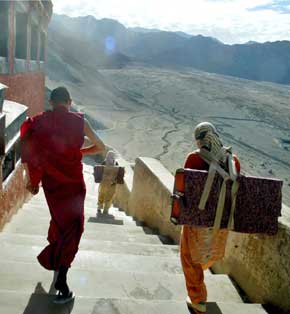Ladakh - the land of Vajrayana Buddhism
by Rohan L. Jayetilleke, Lanka Daily News, Feb 2, 2005
Leh, Ladakh (India) -- With the holding of the Second Buddhist Council by Monks of Vaisali, known as Vajjaputtakas, the Maha Sangha came to be divided into twelve sects. Vajrayana and Mahayana were two of such sects. In Ladakh, Vajrayana persisted even after the Buddhist missions of Emperor Asoka.
 Ladakh is a land like no other; mystic, pristine and remote. Belted by snow-capped peaks, rugged mountainscapes sculpted by time, wind and glacial ice. These natural barriers have constantly and powerfully guarded the beauty of Ladakh.
Ladakh is a land like no other; mystic, pristine and remote. Belted by snow-capped peaks, rugged mountainscapes sculpted by time, wind and glacial ice. These natural barriers have constantly and powerfully guarded the beauty of Ladakh.
Even today Ladakh, has not lost even an iota of her natural beauty and could be termed the last Shangri-La of India. The people are of Mon ancestry (Chinese).
For centuries Ladakh was at the crossroads of major trade routes, despite the difficult terrain.
The traders' (Vaisya Sresthins) caravans travelled through the mountain passes. They brought tea, tobacco and minerals and took away silk, spices, saffron, brocades and shawls.
The family of the erstwhile rulers of Ladakh live in the Stok Palace, just outside the capital Leh. Stok has a miniature museum of family heirlooms giving a viewer an insight into another age.
On the main highway to Kargil lies Shey, the capital of Ladakh, providing a panoramic view of the Sindhu (River Indus) and the Indus Valley, where civilisation began over 5,000 BC, in the pre-Aryan age.
The Vajrayana School of Buddhism forms the bedrock of the Ladakh people. There are around 30 monasteries. These monasteries are the glory and sustainability of Ladakh both spiritually and materially.
The relationship of the monasteries with the people is through the Lamas who conduct religious services and the people endow the monasteries with material offerings. The Hemis is the largest and richest of the Gompas (monasteries) in Ladakh.
Every summer, the Hemis has elegant dance dramas based on Jataka stories. This festival is dedicated to Guru Padma Sambhava, who brought Vajrayana Buddhism to Ladakh.
The term 'Gompa' denotes a solitary place conducive to meditation and meditation centres like the Thikse Gompa are perched high above the surrounding villages, giving the villagers, a sight pleasing to the eye and a spiritual inspiration.
This Thikse Gompa was established about 500 years ago and is continuing with the same zeal and religiosity even today.
Every family in Ladakh gives a son to the Lamas fraternity for ordination. Young boys of the age of five or six are sent to the monasteries to be educated and trained as monks. As such, the order continues without any shortfalls.
Buddhism envelops the daily lives of the people and it is not restricted to only observances on days of religious observances. This is manifested with every citizen participating in religious festivals and rituals.
An important day of the Ladakh calendar is the Buddhist New year, the Losar festival. This is celebrated with the family and friends over 'tampa' (roasted barley flour) and 'chang' (a local brew of fermented barley water).
The other traditional sweetmeats are traditional Mok-Moks, all prepared with their agricultural harvests.
Another important day of festivity is when the religious texts are brought out from the temples and taken out in colourful processions.
The people pay their obeisance and the procession en route stops at households where the residents offer refreshments to those participating in the procession.
There is traditional music and dance and the people are always in their colourful traditional costumes. School children in orderly manner assemble to receive the blessings of the Lamas. Ladakh is a casteless society.
Ladakh is a high altitude cold desert with a minimal rainfall and vegetation in thin strips around the Sindhu or Indus river. In some places, the snow-fed stream provide water in summer and they are used very sparingly for cultivation.
Unfettered by the vagaries of weather and the hilly terrain, people have adopted themselves admirably to the environmental hazards and in the brief months of summer they grow either barely and or wheat.
The ploughs are drawn by the hardy 'Dzo', a cross bred of a yak and a cow, which is the main helper of the farmer.
Livestock farming is predominant in Ladakh and the most precious animal is the hardy pashmina goat, providing them with milk. The people are vegetarians. Sheep too are reared and the wool is used to weave shawls.
The winters are long and severe and the houses are built in such a way to conserve heat, that six months of the year people and livestock live indoors.
Ladakhi women during these six months of naturals confinement to their homes spin wool that provides yarn for garments and thick rugs and carpets. This provides them with not only winter essentials but also a task to be engaged in.
Though the land is a barren desert of high mountains, Buddhism holds sway over the land and the people are bestowed with courage, humility and resilience to withstand the vagaries of elements and terrain.
This is manifested to a visitor in the welcoming smile of the people both very young and old. It is a smile of eternal and internal peace ingrained in them through Buddhism.

 Ladakh is a land like no other; mystic, pristine and remote. Belted by snow-capped peaks, rugged mountainscapes sculpted by time, wind and glacial ice. These natural barriers have constantly and powerfully guarded the beauty of Ladakh.
Ladakh is a land like no other; mystic, pristine and remote. Belted by snow-capped peaks, rugged mountainscapes sculpted by time, wind and glacial ice. These natural barriers have constantly and powerfully guarded the beauty of Ladakh.